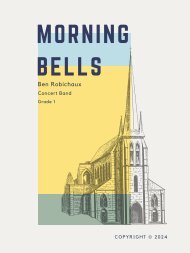A New Day Full Score
Create successful ePaper yourself
Turn your PDF publications into a flip-book with our unique Google optimized e-Paper software.
is borrowed from m.13, before enlogating on beats 3 and 4 of m.49, which mimics the very<br />
first two beats of the piece (pickups to m.1). It will return in an elongated version to assist in<br />
transitioning to the closing section in m.90 and 91.<br />
Return of Introduction m.50-62<br />
This is very similar to the beginning, except at a faster tempo, with the motif from the<br />
transition still present at m.55-56. The sustained concert C in m.57 is truly not answered<br />
until the very last note. This is why I chose to score the last note as a concert Bb in every<br />
part.<br />
Percussion feature m.63-74<br />
The percussion feature includes a “pedal F”, first in the marimba at m.69, and than reiterated<br />
in the winds in m.72 to set up the return of the A section.<br />
A section returns m.75-82<br />
The A section here is very similar to m.33-40, except that the flute and oboe have the<br />
melody written up the octave from the trumpets and clarinets, and the occurrence of the<br />
overall louder dynamic level found in every part.<br />
Transition material returns m.83-91<br />
This section is similar to m.41-49, except that instead of transitioning completely away from<br />
the A section material, it keeps some of its characteristics, most notably the tambourine in<br />
m.87-90. Measures 90 and 91 are very strategic, using the enlogated version of the motif<br />
from m.48 in m.90:<br />
and in m.91 the use of the f minor chord, derived from the ending of the antecedent phrase<br />
from the A section material (m.24, 36 and 78). These choices create synthesis – the<br />
overlapping of material from different sections, which signals the beginning of the closing<br />
section.<br />
Closing m.92-end<br />
The closing, like the introduction features a conversation, this time between the wind<br />
instruments and percussion section. M.96-97 echoes the introductory material (m.12), m.98<br />
highlights the transition section motif and the low brass line at m.99 and upper woodwinds<br />
line at m.101 features short statements from the A section to bring the work to a close.

















